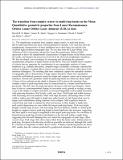The transition from complex craters to multi-ring basins on the Moon: Quantitative geometric properties from Lunar Reconnaissance Orbiter Lunar Orbiter Laser Altimeter (LOLA) data
Author(s)
Baker, David M. H.; Head, James W.; Neumann, Gregory A.; Smith, David Edmund; Zuber, Maria
DownloadZuber_The transition.pdf (3.383Mb)
PUBLISHER_POLICY
Publisher Policy
Article is made available in accordance with the publisher's policy and may be subject to US copyright law. Please refer to the publisher's site for terms of use.
Terms of use
Metadata
Show full item recordAbstract
The morphologic transition from complex impact craters, to peak-ring basins, and to multi-ring basins has been well-documented for decades. Less clear has been the morphometric characteristics of these landforms due to their large size and the lack of global high-resolution topography data. We use data from the Lunar Orbiter Laser Altimeter (LOLA) instrument onboard the Lunar Reconnaissance Orbiter (LRO) spacecraft to derive the morphometric characteristics of impact basins on the Moon, assess the trends, and interpret the processes involved in the observed morphologic transitions. We first developed a new technique for measuring and calculating the geometric/morphometric properties of impact basins on the Moon. This new method meets a number of criteria that are important for consideration in any topographic analysis of crater landforms (e.g., multiple data points, complete range of azimuths, systematic, reproducible analysis techniques, avoiding effects of post-event processes, robustness with respect to the statistical techniques). The resulting data more completely capture the azimuthal variation in topography that is characteristic of large impact structures. These new calculations extend the well-defined geometric trends for simple and complex craters out to basin-sized structures. Several new geometric trends for peak-ring basins are observed. Basin depth: A factor of two reduction in the depth to diameter (d/Dr) ratio in the transition from complex craters to peak-ring basins may be characterized by a steeper trend than known previously. The d/Dr ratio for peak-ring basins decreases with rim-crest diameter, which may be due to a non-proportional change in excavation cavity growth or scaling, as may occur in the simple to complex transition, or increased magnitude of floor uplift associated with peak-ring formation. Wall height, width, and slope: Wall height and width increase with increasing rim-crest diameter, while wall slope decreases; decreasing ratios of wall width to radius and wall height to depth may reflect burial of wall slump block toes by impact melt redistribution during transient cavity collapse. Melt expulsion from the central basin may help to explain the observed increase in floor height to depth ratio; such central depressions are seen within the largest peak-ring basins. Peak-ring height: Heights of peak rings increase with increasing rim-crest diameter (similar to central peak heights in complex craters); peak-ring height to basin depth ratio also increases, suggesting that floor uplift is even larger in magnitude in the largest peak-ring basins. No correlation is found between peak-ring elevation and distance to the rim wall within a single basin, suggesting that rim-wall slumping does not control the topography of peak rings. Offset of peak rings: Peak rings often show minor offset from the basin center. Enhancement in peak-ring elevation in the direction of offset is generally not observed, although this could be a function of magnitude of offset. Basin volume: Volumes of peak-ring basins are about 40% smaller than the volumes predicted by geophysical estimates of the dimensions of corresponding excavation cavities. This difference indicates that collapse of the transient cavity must result in large inward and upward translations of the cavity floor. These new observations of geometric/morphometric properties of protobasins and peak-ring basins place some constraints on the processes controlling the onset and formation of interior landforms in peak-ring basins. Comparisons of the geometric trends of the inner rings of Orientale basin with those of peak-ring basins are generally consistent with a mega-terrace model for the formation of multi-ring basins.
Date issued
2012-12Department
Massachusetts Institute of Technology. Department of Earth, Atmospheric, and Planetary SciencesJournal
Journal of Geophysical Research: Planets
Publisher
American Geophysical Union
Citation
Baker, David M. H., James W. Head, Gregory A. Neumann, David E. Smith, and Maria T. Zuber (2012), The transition from complex craters to multi-ring basins on the Moon: Quantitative geometric properties from Lunar Reconnaissance Orbiter Lunar Orbiter Laser Altimeter (LOLA) data, J. Geophys. Res., 117, E00H16,
Version: Final published version
ISSN
01480227